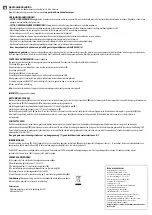
8
4 KH 70 en
5
MAINTENANCE
If the valves suffer any damage due to improper handling or
without the proper authorisation, Metso will not be
responsible. The valves must not be modified except under
express authorisation from Metso.
In order to avoid personal or material damage when
performing the maintenance tasks, it is recommended to
follow these instructions:
The staff responsible for the maintenance or opera-
tion of the equipment must be qualified and trained.
Use suitable Personal Protective Equipment (PPE)
(gloves, safety boots, goggles…).
Shut off all lines that affect the valve and put up a
warning sign to inform about the work being per-
formed.
Completely isolate the valve from the whole process.
Depressurise the process.
Drain all the line’s fluid through the valve.
Use hand tools not electric tools during the mainte-
nance, in accordance with EN13463‐1(15).
The only maintenance required in this type of valve is to
change the packing’s rubber joint and the rubber seals. It is
recommended to carry out regular checks on the sleeves.
The duration of these seals will depend on the valve’s
working conditions, such as: Pressure, temperature,
number of operations, type of fluid and others.
In an ATEX zone, electrostatic charges may be
present inside the valve, which can cause a risk
of explosion. The user will be responsible for
carrying out the appropriate actions in order to minimise
the risks.
The maintenance staff must be informed about the risks of
explosion and ATEX training is recommended.
If the fluid transported constitutes an internal
explosive atmosphere, the user must regularly
check the installation’s correct watertight
integrity.
Regular cleaning of the valve to prevent accumulation of
dust. Assemblies not permitted at the end of the line.
Avoid re‐painting the products supplied.
5.1
Important safety aspects
In order to work under ideal safety conditions, the
magnetic and electrical elements must be in idle
mode and the air tanks depressurised. The electrical
control cabinets must also be out of service. The
maintenance staff must be up to date with the safety
regulations and work can only start under orders
from the site’s safety staff.
The safety areas must be clearly marked and you
must avoid placing auxiliary equipment (ladders,
scaffolding, etc.) on levers or mobile parts which will
lead to the movement of the gate valve.
In equipment with spring return actuators, the gate
must be mechanically locked and only unlocked
when the actuator is pressurised.
In equipment with electrical actuator, it is recom-
mended to disconnect it from the mains in order to
access the mobile parts without any risk.
Due to its great importance, you must check that the
valve’s axle has no load before disassembling the
actuator system.
Taking into account the recommendations indicated, below
we indicate the maintenance operations carried out in this
type of equipment:
5.2
Replacing the sealing joint
1.
Make sure there is absolutely no pressure and fluid in the
installation.
2.
Remove the valve from the pipeline.
3.
Place the gate (2) in open position.
4.
The sleeves (7) are replaced from outside the valve’s
body, it is a seat with two symmetrical parts, below we
show a diagram of the seat (fig.6).
5.
Once the sleeves have been removed, clean their hous-
ing thoroughly.
6.
Once they have been lubricated with Vaseline, insert
the new sleeves (7) of the same dimensions as those
old ones.
7.
Replace the valve between the flanges, taking special
care not to damage the sleeves.
8.
Before starting up the installation, perform various
operations to open and close the valve.
*Note:
The numbers in brackets refer to the components
list in Table 5.
*Note:
During the assembly of the new sleeves it is
recommended to apply “Vaseline” to the seal to facilitate
the assembly process and the valve’s correct operation (do
not use oil or grease), below in Table 3 we show details of
the Vaseline used.
Fig. 6
Tabla 3
WHITE PETROLEUM JELLY
Saybolt Colour
ASTM D‐156
15
Melting point (ºC)
ASTM D‐127
60
Viscosity at 100ºC
ASTM D‐445
5
Penetration 25ºC mm/10
ASTM D‐937
165
Silicone content
None
Pharmacopeia BP
OK






























